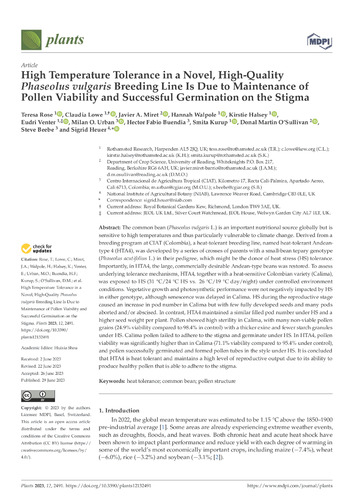High temperature tolerance in a novel, high-quality Phaseolus vulgaris breeding line is due to maintenance of pollen viability and successful germination on the stigma
The common bean (Phaseolus vulgaris L.) is an important nutritional source globally but is sensitive to high temperatures and thus particularly vulnerable to climate change. Derived from a breeding program at CIAT (Colombia), a heat-tolerant breeding line, named heat-tolerant Andean-type 4 (HTA4), was developed by a series of crosses of parents with a small-bean tepary genotype (Phaseolus acutifolius L.) in their pedigree, which might be the donor of heat stress (HS) tolerance. Importantly, in HTA4, the large, commercially desirable Andean-type beans was restored. To assess underlying tolerance mechanisms, HTA4, together with a heat-sensitive Colombian variety (Calima), was exposed to HS (31 °C/24 °C HS vs. 26 °C/19 °C day/night) under controlled environment conditions. Vegetative growth and photosynthetic performance were not negatively impacted by HS in either genotype, although senescence was delayed in Calima. HS during the reproductive stage caused an increase in pod number in Calima but with few fully developed seeds and many pods aborted and/or abscised. In contrast, HTA4 maintained a similar filled pod number under HS and a higher seed weight per plant. Pollen showed high sterility in Calima, with many non-viable pollen grains (24.9% viability compared to 98.4% in control) with a thicker exine and fewer starch granules under HS. Calima pollen failed to adhere to the stigma and germinate under HS. In HTA4, pollen viability was significantly higher than in Calima (71.1% viability compared to 95.4% under control), and pollen successfully germinated and formed pollen tubes in the style under HS. It is concluded that HTA4 is heat tolerant and maintains a high level of reproductive output due to its ability to produce healthy pollen that is able to adhere to the stigma.

